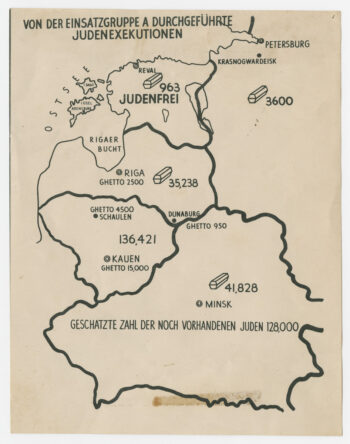Stahlecker Reports
During his time as commander of Einsatzgruppe A since Germany’s invasion of the Soviet Union, SS Brigadeführer Walter Stahlecker compiled two extended reports on the structure, personnel and activities of his task force. The first of these so-called Stahlecker Reports covers events and activities since the outbreak of hostilities until and including 15 October 1941. It has 143 pages plus 18 appendices with together 78 pages, hence a total of 221 pages. The second report covers events and activities from 16 October 1941 until 31 January 1942. This report is even longer, with its 228 pages of text plus 19 appendices.
Only very small parts of these reports deal with executions. Among other issues, the latter document reported on the civil population’s morale; politics and administration; propaganda; cultural areas; ethnicity; public health; Jews; church; economic policy; food situation; agriculture; industry and trade; resistance movements. Further elaborating on these issues were appendices about ethnicity and churches in Belorussia; religious denominations in Latvia and Estonia; religious life in Estonia; minimum wage and existential minimum; social insurance; age distribution in Latvia; livestock in Lithuania, Latvia and Estonia; types of crops in Latvia and Estonia; employment situation in trade and industry in Latvia.
These reports testify to the vast research and data-gathering activities Stahlecker’s unit unfolded. It shows that the men doing this work and compiling their results were highly educated people rather than a gang of brutish thugs.

On the other hand, the death toll claimed in these reports is truly staggering. The second “Stahlecker Report” lists a total of 143,774 victims of all causes for Lithuania (executions, pogroms etc.). Of the 4,500 Jews who had lived in Estonia in early 1940, this reports states, only some 2,000 stayed behind when the war with Germany began, while some 2,500 fled or were evacuated. Of the remaining 2,000 Jews, none were left on 31 January 1942. A map appended to the report lists as executed (see the illustration):
- Estonia: 963
- Latvia: 35,238
- Lithuania: 136,421
Since Stahlecker died in late March of 1942 after a partisan attack, he did not compile any later reports such as these, and his successors evidently did not have the intention or resources to follow in Stahlecker’s ambitious footsteps. However, there are other summary documents created by the Einsatzgruppen which testify to a similar diversity of activities. (For more details, see Mattogno 2022c as well as the entry on the Einsatzgruppen.)

You need to be a registered user, logged into your account, and your comment must comply with our Acceptable Use Policy, for your comment to get published. (Click here to log in or register.)